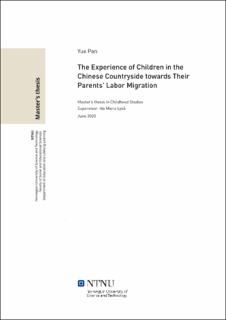| dc.description.abstract | In China, the rural to urban labor migration that started after the initiation of the Open Door Policy resulted in a total of 277.5 million migrant workers, which composed 36% of the workforce in China. This migration led to great impacts on the nation’s economy but also in structures of Chinese families. ‘Home-staying’ children are used to describe children whose father and/or mother work outside the rural community as migrant laborers, with one parent (usually mother), grandparents, relatives or neighbors as the caretakers in their daily situations. In 2015, there were over 60 million ‘home-staying’ children in China. There has been great attention in the public towards ‘home-staying’ children. However, the image of ‘home-staying’ children in the public has often remained biased. The helpless children was the common narrative when ‘home-staying’ children have been described in charity appeals and media.
With regards to such discourses, the question arose as to whether these children’s everyday life experience was accurately described by the public. Thus, this study aims to explore Chinese rural children’s experiences and knowledge towards their parents’ migration. More specifically this study seeks to understand the important aspects in their everyday lives; the relationships of these children with their families, school, and friends and how these relations impact on their life experience; and finally how labor migration transformed their childhood.
A total of 19 children from thirteen to fifteen years of age participated in the research. Five were not home-staying children, and fourteen were home-staying children. This study uses the social studies of childhood as the theoretical framework, together with concepts such as discourse, generational order, dependence and interdependence, and Chinese individualism, perspectives which also connect with the methodology and analysis of this research. This study uses qualitative and participatory research methods including participant observation, naming, household visits, drawing/recalling, photovoice, semi-structured interviews, and in-depth interviews in attempts of gaining an understanding of participants’ everyday life experience.
In the first analysis, the discussion will focus on the construction of ‘home-staying’ childhood. By implementing the concept of discourse and social construction theories, the helpless child discourse and how ‘home-staying’ children perceived this narrative will be elaborated. Furthermore, this chapter will explore how the ‘home-staying’ childhood was constructed by social, historical, and cultural contexts and how this particular childhood was understood by different actors.
The second analysis will discuss how societal changes potentially (re)shape the family relations of ‘home-staying’ children. In addition to labor migration, this chapter will also address on education reform and Internet access, which were two aspects that stood out in the fieldwork as essential life experience of participants. Using concept of generational order, this chapter will discuss how the family structures and caregiving structures have changed. Furthermore, this chapter will elaborate on how the childhood of ‘home-staying’ children is immersed in complexities in terms of spatiality, interdependence, collectivity, and individualism.
This study was conducted in hope of supplementing the growing body of the social studies of childhood. It also hopes to bring more understanding about ‘home-staying’ children’s everyday life with their own experience and knowledge. | |
